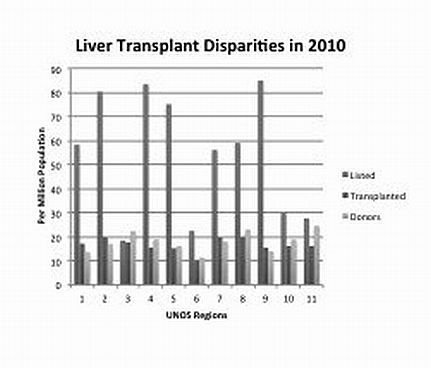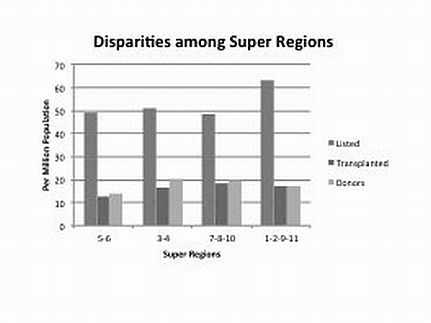Super Regions Can Reduce Geographic Disparities in Liver Transplantation
Abdominal Transplantation, University of Arizona, Tucson
Meeting: 2013 American Transplant Congress
Abstract number: D1644
Context: The significant geographic disparities in liver transplantation have been a point of contention in the transplant community. In the attempt to establish greater equity, several regional sharing allocation schemes have been proposed including the share 15 and share 35 plans.
Objective: Our objective was to investigate regional disparities in liver allograft supply and demand and to devise a scheme to reduce these disparities.
Methods: Publically accessible SRTR data and the OPTN database provided de-identified patient-level data on donors allografts, waitlisted patients, and transplants performed by region. 2010 United States Census provided population data for each region. 16,980 waitlisted patients and 5,993 transplant recipients were analyzed.
Results: The disparities in listed candidates, transplant recipients, and donors available by region per million population are illustrated in figure 1. In region 9, there are 85 patients listed per million population while only 14 donors are available and 15 transplants are conducted per million population. This is contrasted by region 3, where 18 patients are listed per million population while 17 transplants are performed and 22 donors are available for transplantation per million population.

These disparities can be reduced by combining adjacent regions to form super regions.

The disparities in MELD score at transplant and 1 year survival are also reduced.
Conclusion: Geographic disparities in donor allograft supply and demand are dramatic. Combining adjacent regions into super regions can reduce this disparity.
To cite this abstract in AMA style:
Rana A, Porubsky M, Jie T, Habib S, Rilo H, Kaplan B, Gruessner A, Gruessner R. Super Regions Can Reduce Geographic Disparities in Liver Transplantation [abstract]. Am J Transplant. 2013; 13 (suppl 5). https://atcmeetingabstracts.com/abstract/super-regions-can-reduce-geographic-disparities-in-liver-transplantation/. Accessed December 9, 2025.« Back to 2013 American Transplant Congress
